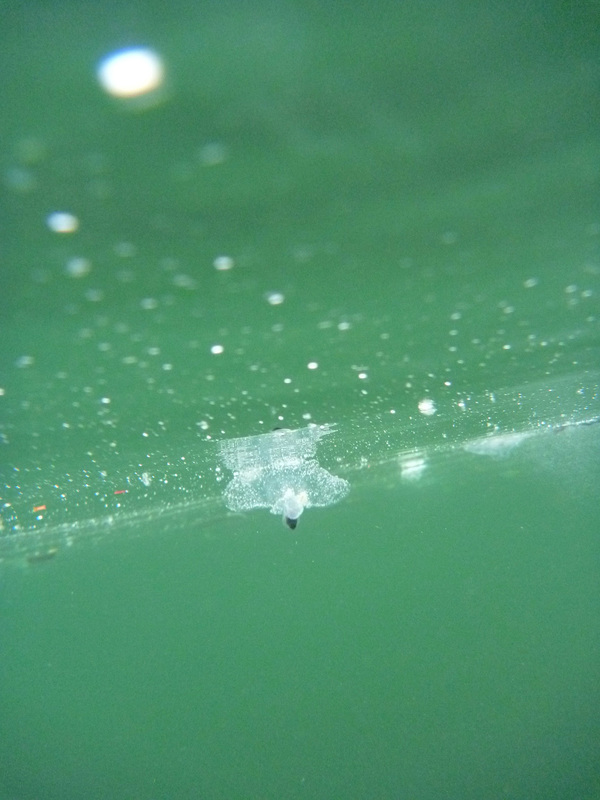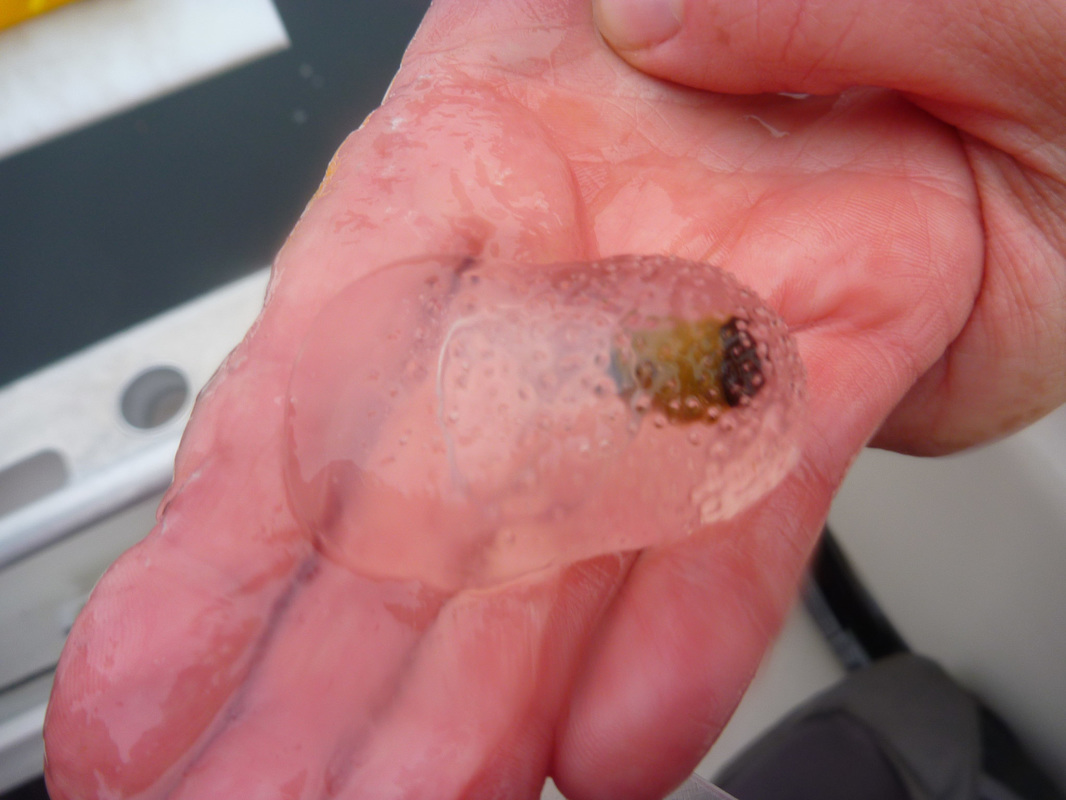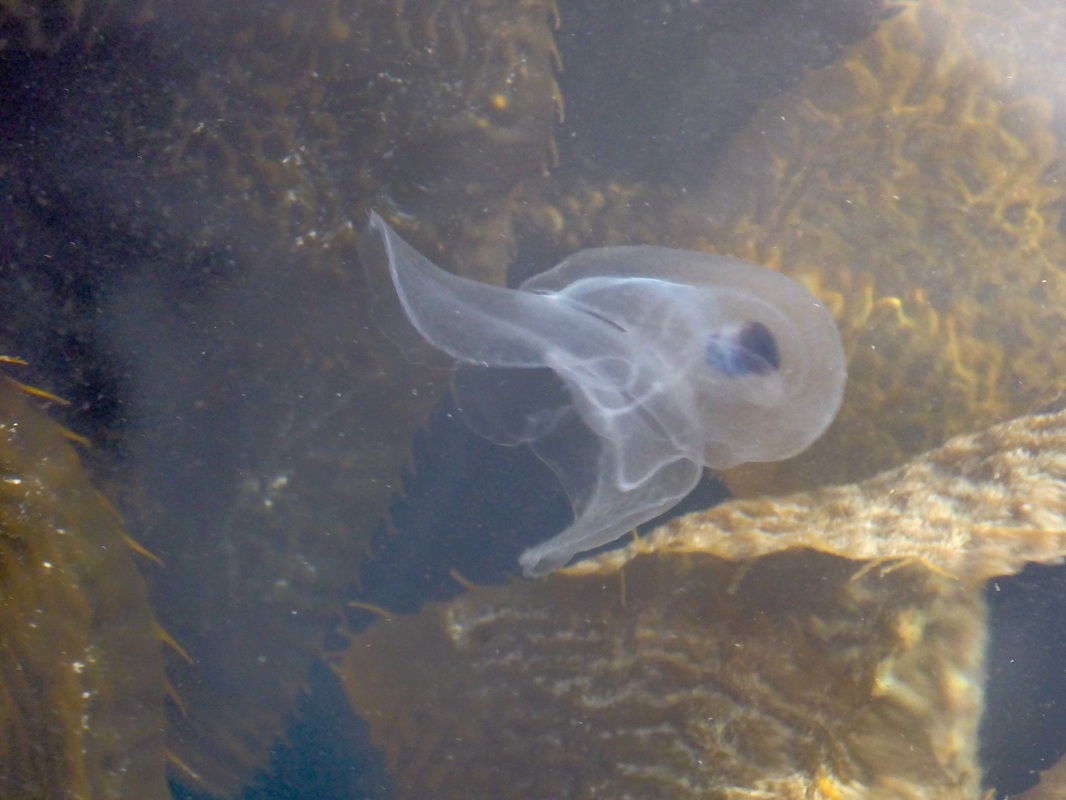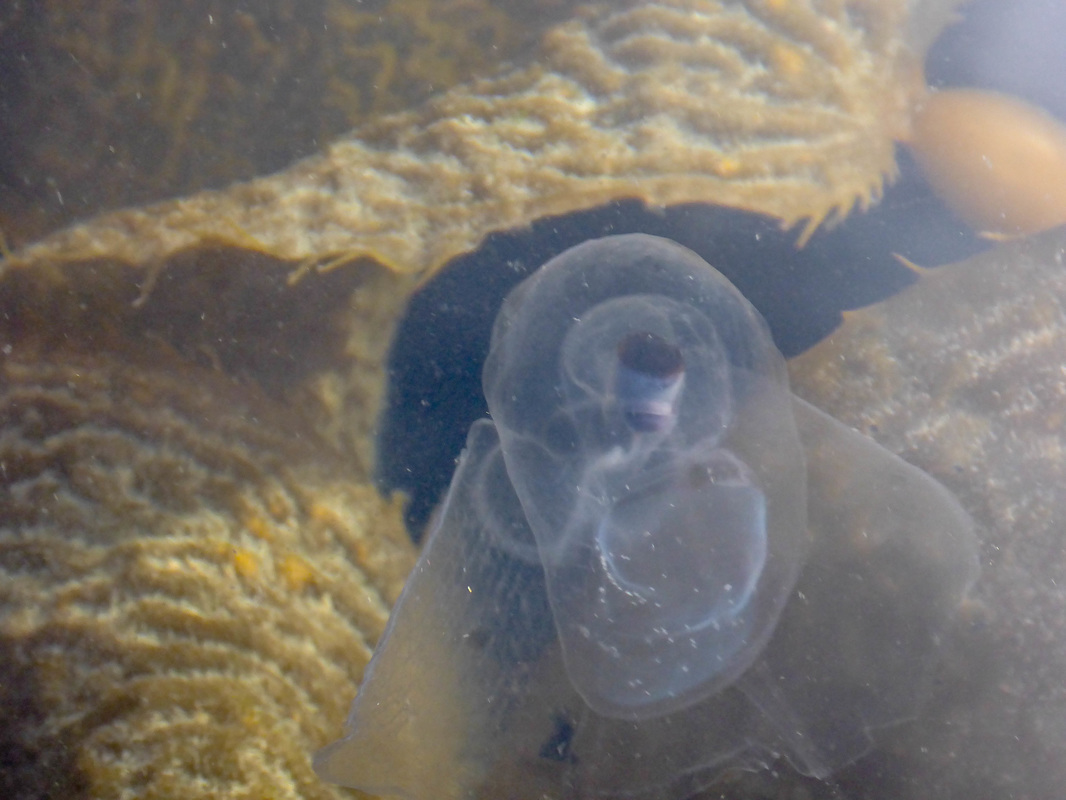Sea butterfly • Corolla spectabilis
Top left: sea butterfly at the ocean's surface. Bottom left: sea butterfly with wings still attached (but barely visible); the darker spot is the animal's gut. Both photos by Angeleen Olson. Top and middle right: a sea butterfly swimming amongst Macrocystis pyrifera. Bottom right: a sea butterfly's pseudoconch washed up on a beach, photographed by Kelly Fretwell. Note how the tubercles give the pseudoconch a bumpy texture.
Identification
This gelatinous and almost completely transparent animal may look like an oddly-shaped jellyfish in water — or like a colourless nudibranch when it washes ashore — but it is actually free-swimming marine snail called a pteropod (meaning "wing-foot"). It swims using large oval-shaped wing plates, which it flaps in a bird-like fashion. Instead of a hard outer shell, the animal is protected and given structure by a gelatinous pseudoconch ("false shell"), which is often all that remains of this species when it washes up on shore. The pseudoconch is relatively solid and is covered in tubercles which give it a bumpy texture. It has a slipper-like shape, with a hollowed-out pocket at one end of the underside. The animal has a non-transparent gut visible as a dark internal spot. The body core (composed of the pseudoconch and internal organs all covered by the mantle; these structures are visible in this image) gets to about 2.5 cm long, while the "wing span" reaches 8 cm across.
Habitat & Range
The sea butterfly is a pelagic animal, found in open ocean on the west coast of North America from southern California to BC or possibly further northward; it has also been reported in the North Atlantic Ocean. It can form large aggregations.
Similar Species
This animal is quite distinctive. It has been occasionally identified as Corolla calceola, which is not present in the eastern Pacific; C. spectabilis is the only species of this genus found in the region.
Intriguing Info
The sea butterfly produces a large and delicate sheet of mucous using mucous glands on its wings (12 glands on each) and its proboscis; this sheet captures planktonic food and can measure up to 2 m across. While this creature tends to swim slowly, it detaches its mucous sheet and speeds up its pace when disturbed, and has been recorded at speeds up to 45 cm per second!
This gelatinous and almost completely transparent animal may look like an oddly-shaped jellyfish in water — or like a colourless nudibranch when it washes ashore — but it is actually free-swimming marine snail called a pteropod (meaning "wing-foot"). It swims using large oval-shaped wing plates, which it flaps in a bird-like fashion. Instead of a hard outer shell, the animal is protected and given structure by a gelatinous pseudoconch ("false shell"), which is often all that remains of this species when it washes up on shore. The pseudoconch is relatively solid and is covered in tubercles which give it a bumpy texture. It has a slipper-like shape, with a hollowed-out pocket at one end of the underside. The animal has a non-transparent gut visible as a dark internal spot. The body core (composed of the pseudoconch and internal organs all covered by the mantle; these structures are visible in this image) gets to about 2.5 cm long, while the "wing span" reaches 8 cm across.
Habitat & Range
The sea butterfly is a pelagic animal, found in open ocean on the west coast of North America from southern California to BC or possibly further northward; it has also been reported in the North Atlantic Ocean. It can form large aggregations.
Similar Species
This animal is quite distinctive. It has been occasionally identified as Corolla calceola, which is not present in the eastern Pacific; C. spectabilis is the only species of this genus found in the region.
Intriguing Info
The sea butterfly produces a large and delicate sheet of mucous using mucous glands on its wings (12 glands on each) and its proboscis; this sheet captures planktonic food and can measure up to 2 m across. While this creature tends to swim slowly, it detaches its mucous sheet and speeds up its pace when disturbed, and has been recorded at speeds up to 45 cm per second!
|
Left: clip filmed by Sara Wickham.
|
|
References
Mills, C. E. (2003). Acta Errata. University of Washington, Seattle. Accessed 24/03/2016.
Rudman, W. B. (2002). Corolla spectabilis Dall, 1871. Sea Slug Forum. Australian Museum, Sydney. Accessed 24/03/2016.
Wrobel, D. Corolla spectabilis Dall, 1871 : Sea Butterfly. JelliesZone. Accessed 24/03/2016.
Authors and editors of page
Kelly Fretwell (2016).
Mills, C. E. (2003). Acta Errata. University of Washington, Seattle. Accessed 24/03/2016.
Rudman, W. B. (2002). Corolla spectabilis Dall, 1871. Sea Slug Forum. Australian Museum, Sydney. Accessed 24/03/2016.
Wrobel, D. Corolla spectabilis Dall, 1871 : Sea Butterfly. JelliesZone. Accessed 24/03/2016.
Authors and editors of page
Kelly Fretwell (2016).








